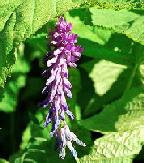

Northern Sweetvetch
Hedysarum boreale Nutt.
var camescems Nutt.
Presents a bushy appearance with numerous branched stems, one to two feet tall. The leaves are pinnately compound with seven to fifteen oval leaflets. It has reddish or purple flowers, bilaterally symmetrical and pea-like, forming congested, elongate and showy racemes. It flowers in late spring or early summer. It grows in fine textured and light clay soils or in gravelly, rocky slopes. Reported by Nuttall on plains of the Rocky Mountains, particularly near Lewis's (Snake) River, now southeastern Idaho. Found throughout the Rocky Mountain region.
Food Use:
It was collected and eaten by Indians. The
roots have a licorice flavor and it is both tasty and nutritious. The young tender
roots may be eaten raw or cooked. It may also be sliced and eaten raw, boiled, baked or added to
soups.
Planting:
Hardy plant. Can be grown
in anything from a light to heavy soil mixture, but it is preferable to plant in
a well drained soil. Generally cannot be successfully
grown in areas where the soil quality is of a poor standard, is lacking in
sufficient nutrients. Best planted within full sun and moist position.